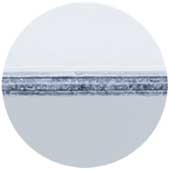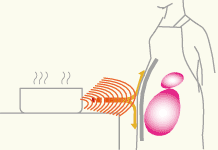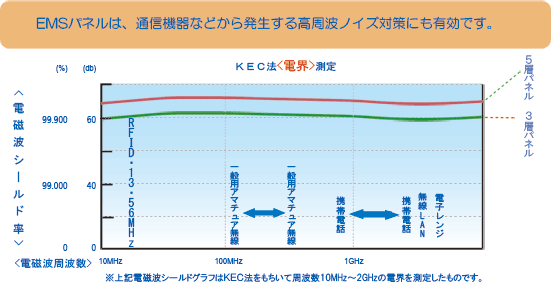MG Apron Menu(Tap to display menu)
Various Electromagnetic Protective Clothing
How electromagnetic wave protection works
EMS Padblocks AC magnetic fields. If an AC magnetic field is applied to the loop surface (inside the loop) created by the telemetry coil and lead inside the device, such as a pacemaker or ICD, it can cause the device to malfunction. Placing two "EMS pads" on the front and back of the body to cover the loop surface will efficiently block AC magnetic fields.
In addition, even if an AC magnetic field enters the loop surface from the side, it is hardly incident on the loop surface (inside the ring), so the influence of the AC magnetic field from the side is very small. Rather, the influence of the AC magnetic field entering from the front and back due to the magnetic field bending around is greater, so it is optimal to place "EMS pads" on the front and back.
Comparison with other companies' products
MG apron
Compatible with mobile phones, induction cookers, and induction rice cookers.
Other companies
Currently, other companies do not sell electromagnetic protection clothing for pacemakers, ICDs, etc.
EMS pads
Five-layer EMS pad (insert into your inner clothing pocket) that attenuates low-frequency magnetic fields from 30kHz to 300kHz by 45 to 60dB (99.35 to 99.99%). *Made of lightweight, soft material.

- 1.Low Frequency Magnetic Field
- 2.3 layers of aluminum foil
- 3.High permeability magnetic material sheet, 2 layers
- 4.Magnetic field shielding

※Enlarged cross-sectional view
Five-layer structure (thickness 0.7 mm) consisting of three layers of aluminum film and two layers of high-permeability magnetic material sheets
Comparison of electromagnetic shielding between our products and conventional products (materials)
The electromagnetic wave shielding graph above shows the measurement of "shielding magnetic field strength" at frequencies from 0Hz to 1000KHz. EMS pads shield low-frequency magnetic fields generated by AC currents and induction cookers, which conventional coating materials have little shielding ability. The graph below shows electric field shielding data measured by the KEC method for high-frequency electromagnetic wave noise.


Theoretical support
1. Theoretical formula for electromagnetic shielding effectiveness
![]()
![]()
The larger S, the greater the electromagnetic shielding effect. Therefore, it is necessary to select a material with a large δ for the electromagnetic shielding material. For the EMS pad, a high-permeability magnetic material sheet (120 μm thick) was used.

2. Improved electromagnetic shielding rate through multi-layering of materials
The theoretical formula for the electromagnetic shielding effect S when the material is multi-layered is shown below.

The larger S is, the higher the electromagnetic shielding effect is. Electromagnetic shielding performance is improved by laminating electromagnetic shielding materials. The EMS pad is made up of a five-layer structure of aluminum foil and high-permeability magnetic material sheets.
3. Shielding magnetic field strength measurement test
The shielding magnetic field strength is measured using the following method [Figure 2]. A tracking pulse is transmitted from a transmitting loop antenna and received by a receiving loop antenna separated by the material under test, and the shielding strength is measured.

▲ Figure 2. Shielding magnetic field strength measurement test method
The results of the shielding magnetic field strength measurement test for the EMS pad are shown in Figure 3. This sheet is made up of a five-layer structure of aluminum foil and high-permeability magnetic material sheets, and despite its thickness of 0.7 mm, a shielding magnetic field strength measurement test at the material value confirmed a maximum shielding rate of approximately 60 dB (99.9%) in low-frequency electromagnetic fields from 100 Hz to 300 kHz. It has been confirmed that the low-frequency electromagnetic field emitted by induction cookers has the strongest energy in the 20 kHz to 30 kHz range, and the shielding rate in this vicinity was confirmed to be 60 dB (99.9%).

▲Figure 3. Shielding performance measurement data
(※Note: This is a logarithmic scale of 10 squared, so it is not uniform.)
References: Latest Electromagnetic Wave Absorption and Shielding, Nikkei Technical Books



